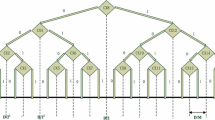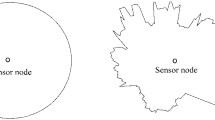Abstract
The minimized amount of Localization accuracy is one of the common issues in Wireless sensor networks. The determination of unknown nodes in a network needs good localization approach. This paper proposes a 3-dimensional Manifold and Machine Learning based Localization algorithm for providing the solution to the localization problem. The Machine Learning uses to identify the faulty nodes in the network for better efficiency and computes the optimal solution to the real-time localization problems in WSNs. The mobility model is deployed within the sensor node and the sensor node is computed to estimate the position of the sensor node. This technique is utilized to identify the position of the unknown nodes according to the transmission range. Machine Learning technique utilizes to identify the faulty nodes from the sensor nodes for obtaining the maximum efficiency. RMSE is used to measure the errors for providing better accuracy and also increase the level of quantization for WSN localization approach. The simulation results prove that the proposed technique has high accuracy, reduced energy consumption compared with the relevant techniques.










Similar content being viewed by others
References
Erdemir, E., & Tuncer, T. E. (2018). Path planning for mobileanchor based wireless sensor network localization: Static and dynamic schemes. Ad Hoc Networks, 77, 1–10.
Singh, P., Khosla, A., Kumar, A., & Khosla, M. (2018). Computational intelligence based localization of moving target nodes using single anchor node in wireless sensor networks. Telecommunication Systems, 69(3), 397–411.
Lv, C., Wang, Q., Yan, W., & Li, J. (2018). A sparsity feedback-based data gathering algorithm for wireless sensor networks. Computer Networks, 141, 145–156.
Sadowski, S., & Spachos, P. (2018). RSSI-based indoor localization with the Internet of things. IEEE Access: Practical Innovations, Open Solutions, 6, 30149–30161.
Das, T., & Roy, S. (2015, December). Energy efficient and event driven mobility model in mobile WSN. In Proceedings of the IEEE international conference on advanced networks & telecommunications systems, Kolkata, India (pp. 1–6).
Chen, Y., Lu, S., Chen, J., & Ren, T. (2016). Node localization algorithm of wireless sensor networks with mobile beacon node. Peer-to-Peer Networking and Applications, 10(3), 1–13.
Kang, J., Park, Y. J., Lee, J., Wang, S. H., & Eom, D. S. (2018). Novel leakage detection by ensemble CNN-SVM and graph-based localization in water distribution systems. IEEE Transactions on Industrial Electronics, 65(5), 4279–4289.
Sert, S. A., Alchihabi, A., & Yazici, A. (2018). A two-tier distributed fuzzy logic based protocol for efficient data aggregation in multi-hop wireless sensor networks. IEEE Transactions on Fuzzy Systems, 26(6), 3615–3629.
Ayyasamy Ayyanar, M., Archana, Y., Harold Robinson, E., Golden Julie, R. K. & Le, H. S. (2019). Design a prototype for automated patient diagnosis in wireless sensor networks. Medical & Biological Engineering & Computing, 57, 2373–2387
Vimal, S., et al., (2016). Secure data packet transmission in MANET using enhanced identity-based cryptography. International Journal of New Technologies in Science and Engineering, 3(12), 35–42.
Zhou, Y., Yang, L., Yang, L., & Ni, M. (2019). Novel energy-efficient data gathering scheme exploiting spatial-temporal correlation for wireless sensor networks. Wireless Communications and Mobile Computing, 2019, 1–10, Hindawi Publishing Coorporation.
Song, X. C., Zhao, Y. S., & Wang, L. Z. (2018). Gauss–Markov-based mobile anchor localization (GM-MAL) algorithm based on local linear embedding optimization in internet of sensor networks. Cognitive Systems Research, 52, 138–143.
Kaliappan, E., Mariappan, M., & Vimal, S. (2016). Energy efficient routing protocol using Grover’s searching algorithm using MANET. Asian Journal of Information Technology, 15(24), 2016.
Ilango, S. S., Vimal, S., Kaliappan, M., et al. (2018). Optimization using Artificial Bee Colony based clustering approach for big data. Cluster Computing. https://doi.org/10.1007/s10586-017-1571-3.
Kannan, N., Sivasubramanian, S., Kaliappan, M., Vimal.s, A., & Suresh. (2018). Predictive big data analytic on demonetization data using support vector machine. Cluster Computing. https://doi.org/10.1007/s10586-018-2384-8.
Suresh Annamalai, U. R., & Vimal, S. (2019). An intelligent grid network based on cloud computing infrastructures. Novel Practices and Trends in Grid and Cloud Computing, pp. 59–73, https://doi.org/10.4018/978-1-5225-9023-1.ch005.
Kumar, D. P., Amgoth, T., & Annavarapu, C. S. (2019). Machine learning algorithms for wireless sensor networks: A survey. Information Fusion, 49, 1–25.
Fatemeh Darakeh, G.-R., Mohammad-Khani, P., & Azmi, D. C. R. L.-W. S. N. (2018). A distributed cooperative and range-free localization algorithm for WSNs. AEU-International Journal of Electronics and Communications, 93, 289–295.
Ayyasamy, A., Golden Julie, E., Harold Robinson, Y., Balaji, S., Kumar, R., & Son, L. H., Thong, P. H. & Priyadarshini, I. (2020). AVRM: Adaptive void recovery mechanism to reduce void nodes in wireless sensor networks. Peer-to-Peer Networking and Applications, 13, 987–1001.
Zhao, Y., Xu, J., & Jiang, J. (2018, December). RSSI based localization with mobile anchor for wireless sensor networks. In Proceedings of the 2018 international conference on geo-spatial knowledge and intelligence (pp. 176–187), Chiang Mai, Thailand.
Langendoen, K., & Reijers, N. (2013). Distributed localization in wireless sensor networks:a quantitative comparison. Computer Networks, 43(4), 499–518.
Mohamed, R. E., Saleh, A. I., Abdelrazzak, M., & Samra, A. S. (2018). Survey on wireless sensor network applications and energy efficient routing protocols. Wireless Personal Communications, 101(2), 1019–1055.
Balaji, S., Golden Julie, E., & Harold Robinson, Y. (2019). Development of fuzzy based energy efficient cluster routing protocol to increase the lifetime of wireless sensor networks. Mobile Networks and Applications, 24, 394–406.
Singh, P., Khosla, A., Kumar, A., & Khosla, M. (2018). Optimized localization of target nodes using single mobile anchor node in wireless sensor network. AEU-International Journal of Electronics and Communications, 91, 55–65.
Alsheikh, M. A., Lin, S., Niyato, D., & Tan, H. P. (2014). Machine learning in wireless sensor networks: Algorithms, strategies, and applications. IEEE Communications Surveys & Tutorials, 16(4), 1996–2018.
Suresh Annamalai, U. R., & Vimal, S. (2019). Cloud-based predictive maintenance and machine monitoring for intelligent manufacturing for automobile industry. Novel Practices and Trends in Grid and Cloud Computing, pp. 74–81. https://doi.org/10.4018/978-1-5225-9023-1.ch006.
Harold Robinson, Y., & Golden Julie, E., Kumar, R. & Son, L. H. (2019). Probability-based cluster head selection and fuzzy multipath routing for prolonging lifetime of wireless sensor networks. Peer-to-Peer Networking and Applications, 12, 1061–1075.
Khan, & Waqas, M. (2017). Relative positioning via iterative locally linear embedding: A distributed approach toward manifold learning technique. IEEE Sensors Letters, 1(6), 1–4.
Han, G., Jiang, J., Zhang, C., Duong, T. Q., Guizani, M., & Karagiannidis, G. K. (2016). A survey on mobile anchor node assisted localization in wireless sensor networks. IEEE Communications Surveys & Tutorials, 18(3), 2220–2243.
Sivaram, M., Kaliappan, M., Shobana, S. J., et al. (2020). Secure storage allocation scheme using the fuzzy based heuristic algorithm for the cloud. Journal of Ambient Intelligence and Humanized Computing. https://doi.org/10.1007/s12652-020-02082-z.
Karim, L., Nasser, N., Mahmoud, Q. H., Anpalagan, A., & Salti, T. E. (2015). Range-free localization approach for M2M communication system using mobile anchor nodes. Journal of Network and Computer Applications, 47, 137–146.
Angelo, C., & Fascista, A. (2018). On the hybrid TOA/RSS range estimation in wireless sensor networks. IEEE Transactions on Wireless Communications, 17(1), 361–371.
Vimal, S., Kaliappan, M., Suresh, A., Subbulakshmi, P., Kumar, S., & Kumar, D. (2018). Development of cloud integrated internet of things based intruder detection system. Journal of Computational and Theoretical Nanoscience, 15(11-12), 3565–3570.
Lu, Y., & Sun, N. (2018). A resilient data aggregation method based on spatiotemporal correlation for wireless sensor networks. EURASIP Journal on Wireless Communications and Networking, 2018(157), 1–9.
Tomic, S., Beko, M., Tuba, M., & Correia, V. M. F. (2018). Target localization in NLOS environments using RSS and TOA measurements. IEEE Wireless Communications Letters, 7(6), 1062–1065.
Zhong, Z., Luo, D.-Y., Liu, S.-Q., Fan, X.-P., & Qu, Z.-H. (2010). An adaptive localization approach for wireless sensor networks based on Gauss-Markov mobility model. Acta Automatica Sinica, 36(11), 1557–1568.
Bhardwaj, R., & Kumar, D. (2019). MOFPL: Multi-objective fractional particle lion algorithm for the energy aware routing in the WSN. Pervasive and Mobile Computing, 58, 101029.
Ayadi, A., Ghorbel, O., BenSalah, M. S., & Abid, M. (2020). Spatio-temporal correlations for damages identification and localization in water pipeline systems based on WSNs. Computer Networks, 171, 107134.
Despaux, F., Jaffres-Runser, K., Bossche, A. V. D., & Val, T. (2016, September). Accurate and platform-agnostic time-of-flight estimation in ultra-wide band. In Proceeding of the 27th IEEE international symposium on personal, indoor and mobile radio communications (pp. 1–7), Valencia, Spain.
Sun, Q., Sun, Y., Liu, X., & Xie, Y., Chen, X.-G. (2018). Study on fault diagnosis algo- rithm in WSN nodes based on RPCA model and SVDD for multi-class classification. Cluster Computing, 2018, 1–15.
Harold Robinson, Y., Golden Julie, E., & Saravanan, K., Kumar, R., & Son, L. H. (2020). DRP: Dynamic routing protocol in wireless sensor networks. Wireless Personal Communications, 111, 313–329.
Vijayashree, R., Suresh Ghana, C., & Dhas (2019). Energy efficient data collection with multiple mobile sink using artificial bee colony algorithm in large-scale WSN. Journal for Control, Measurement, Electronics, Computing and Communications, 60(5), 555–563.
Xu, H. (2020). Semi-supervised manifold learning based on polynomial mapping for localization in wireless sensor networks. Signal Processing, 172, 107570.
Pasupathi, S., Vimal, S., Harold-Robinson, Y., et al. (2020). Energy efficiency maximization algorithm for underwater Mobile sensor networks. Earth Science Informatics. https://doi.org/10.1007/s12145-020-00478-1.
Suresh, A., Udendhran, R., & Vimal, S. (2020). Deep neural networks for multimodal imaging and biomedical applications. Hershey: IGI Global. https://doi.org/10.4018/978-1-7998-3591-2.
Vimal, S., Kalaivani, L., Kaliappan, M., Suresh, A., Gao, X.-Z., & Varatharajan, R. (2018). Development of secured data transmission using machine learning based discrete time partial observed Markov model and energy optimization in Cognitive radio networks. Neural Computing and Applications, 32. https://doi.org/10.1007/s00521-018-3788-.
Vimal, S., Kalaivani, L., & Kaliappan, M. (2017). Collaborative approach on mitigating spectrum sensing data hijack attack and dynamic spectrum allocation based on CASG modelling in wireless cognitive radio networks. Cluster Computing. https://doi.org/10.1007/s10586-017-1092-0.
Wu, S., Zhang, S., & Huang, D. (2019). A TOA-based localization algorithm with simultaneous NLOS mitigation and synchronization error elimination. IEEE Sensors Letters, 3(3), 1–4.
Han, K., Xing, H., Deng, Z., & Du, Y. (2018). A RSSI/PDR-based probabilistic position selection algorithm with NLOS identification for indoor localisation. ISPRS International Journal of Geo-Information, 7(6), 232–253.
Bianchi, V., Ciampolini, P., & De Munari, I. (2019). RSSI-based indoor localization and identification for zigbee wireless sensor networks in smart homes. IEEE Transactions on Instrumentation and Measurement, 68(2), 566–575.
Vimal, S., Khari, M., Crespo, R. G., Dey, N., Kalaivani, L., & Kaliappan, M. (2020). Energy enhancement using Multiobjective Ant colony optimization with Double Q learning algorithm for IoT based cognitive radio networks. Computer Communications, 154, 481–490.
Vimal, S., Suresh, A., Subbulakshmi, P., Pradeepa, S., & Kaliappan, M. (2020) Edge computing-based intrusion detection system for smart cities development using IoT in urban areas. In G. Kanagachidambaresan, R. Maheswar, V. Manikandan, K. Ramakrishnan (Eds.), Internet of things in smart technologies for sustainable urban development. EAI/Springer Innovations in Communication and Computing. Cham: Springer.
Acknowledgements
This work was supported by the National Research Foundation of Korea(NRF) Grant funded by the Korea government(MSIT) (NRF-2019R1F1A1060668).
Author information
Authors and Affiliations
Corresponding author
Additional information
Publisher’s note
Springer Nature remains neutral with regard to jurisdictional claims in published maps and institutional affiliations.
Rights and permissions
About this article
Cite this article
Robinson, Y.H., Vimal, S., Julie, E.G. et al. 3-Dimensional Manifold and Machine Learning Based Localization Algorithm for Wireless Sensor Networks. Wireless Pers Commun 127, 523–541 (2022). https://doi.org/10.1007/s11277-021-08291-9
Accepted:
Published:
Issue Date:
DOI: https://doi.org/10.1007/s11277-021-08291-9




